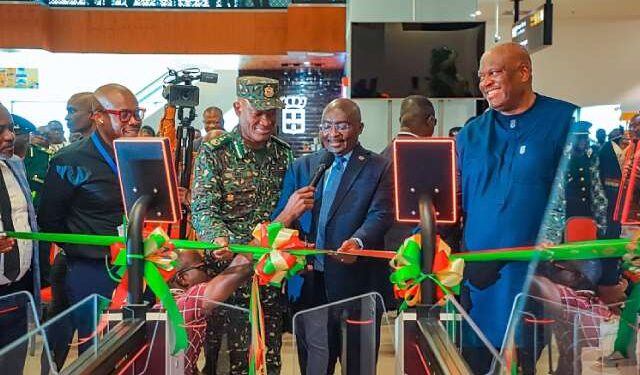$240 Million Immigration E-Gate Controversy: A Case of State Enchantment?
“Big Money, Big Questions: Is Ghana’s New Immigration Project Justified?”
By: NorvanReports Insights Desk
In a compelling critique titled State Enchantment, Mr. Bright Simons, Vice President of IMANI Africa, has accused the Ghanaian government of engaging in what he describes as a “blindingly glorious” but deeply flawed project involving the implementation of a new e-Gate immigration system. Simons alleges gross inefficiencies, cost inflation, and a deliberate bypass of competitive procurement processes, stirring heated debate about public accountability and fiscal responsibility in Ghana.
A Functional System in Place
According to Mr. Simons, Ghana already operates a functional electronic immigration management system that efficiently handles biometric data for millions of passengers at Kotoka International Airport (KIA). “If you’ve used Kotoka Airport before, you’ve seen it in action,” he asserts, pointing to the system’s ability to capture photos and scan fingerprints as evidence of its efficiency.
Simons suggests that this existing system could be incrementally upgraded at minimal cost. Offers from development partners to enhance the system with zero engineering costs, supplemented by ancillary hardware upgrades for no more than $2.5 million, are allegedly on the table but have been ignored. These upgrades, he argues, would suffice to add e-Gates to all borders and centralize e-visa functionalities, which are currently managed separately by various Ghanaian embassies.
The $240 Million Question
The government’s decision to implement a $240 million e-Gate system, under a broader “Immigration 360” initiative, has raised eyebrows. Critics argue that the staggering figure is excessive and disproportionate to Ghana’s economic realities.
Mr. Simons highlights that a physical e-Gate unit costs approximately $10,000 if sourced competitively. The majority of the expense lies in the integration of the immigration management system. However, he contends that this integration was already packaged in a World Bank e-Transform project, which had allocated $16 million for a comprehensive upgrade of Ghana’s immigration systems, including an additional $2.9 million for Terminal 3 integration. The project, he claims, was derailed to make way for the more expensive arrangement.
“Thus, when we say the government wants to spend $240 million on e-Gates, we are CORRECT,” Simons writes. He emphasizes that this figure represents the integrated system as a whole, not merely the physical gates.
Allegations of Monopoly and Sabotage
Mr. Simons alleges that the Vice President’s office interfered with the World Bank-funded project, sabotaging its rollout to pave the way for a new deal with Margins ID Systems Application Ltd. This company, which already provides ID card services under a monopoly arrangement, has been accused of benefiting from inflated costs and preferential treatment.
The project is also criticized for its financial structure. It is reportedly pre-financed by the contractor, who will recoup the investment through public charges. Simons describes this arrangement as a classic “create, loot, and share” scheme that burdens citizens with higher fees while bypassing competitive tender processes.
GIS Responds
In response to the controversy, the Ghana Immigration Service (GIS) issued a statement clarifying that the $240 million figure represents a 10-year lifecycle cost for the Immigration 360 initiative, which includes periodic upgrades, maintenance, and licensing fees. The e-Gate system at KIA, they say, cost $5.5 million, with 15 physical units accounting for $1.7 million of the total.
“The $240 million includes two periodic wholesale upgrades of critical system components and maintenance costs over the 10-year cycle, ensuring operational efficiency and the delivery of a refreshed system at the end of the term,” GIS explained.
The GIS also emphasized that Immigration 360 is a broader initiative designed to automate passenger processing at 48 entry and exit points nationwide, addressing sovereignty, interoperability, and technical inefficiencies in existing systems.
Critics Remain Unconvinced
Despite GIS’s explanation, critics remain skeptical. MP Hon. Kwame Agbodza, Minority Chief Whip, has called the project a “create, loot, and share” scheme, pointing out the apparent disparity between the alleged $147 million cost of the e-Gate system and the $250 million price tag for constructing the entire Terminal 3. Mr. Simons echoes these sentiments, describing the project as an example of state enchantment designed to distract the public from underlying inefficiencies.
He also draws comparisons to the terminated Sibton mobile interoperability project, which was criticized for similar issues of cost inflation and lack of transparency.
Public Financial Burden
Mr. Simons warns that the financial model for the e-Gate system places an undue burden on Ghanaian citizens. With passenger charges expected to increase to cover the $300 million projected cost (including $30 million for passenger data transmission), either the Ghana Immigration Service risks financial instability, or travelers will bear the brunt of inflated fees.
“This is a BIG DEAL,” Bright declares in his reponse, urging citizens to remain vigilant and demand accountability.
Call for Transparency and Debate
Mr. Simons concludes his critique with a call for action. He demands a halt to the project, a forensic audit, and an independent assessment to determine whether Ghana truly needs to spend such a significant sum on immigration technology services. If necessary, he argues, any such initiative should be executed transparently and competitively, avoiding the pitfalls of single-sourcing and cost inflation.
“The World Bank loan secured for this same project would still need to be paid by you, the long-suffering citizens of Ghana!” he warns, underscoring the importance of public scrutiny.
Conclusion
The $240 million e-Gate controversy highlights broader issues of governance, procurement, and fiscal responsibility in Ghana.
While the GIS defends the initiative as a forward-looking investment in border management, critics like Mr Simons argue that it exemplifies wasteful spending and opaque decision-making.
As the debate unfolds, one thing remains clear: the public deserves clarity, accountability, and assurance that their hard-earned taxes are being used judiciously.








